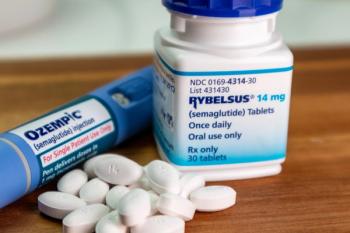
- Vol 38, Issue 5
- Volume 05
Clinical Dilemmas: What’s Good for the Brain Is Good for the Heart
Does it matter which came first, the depression or the heart disease?
Treating depression in the context of any other medical disorders can challenge our usual approaches and frustrate our efforts to reach good outcomes. Not surprisingly, this is especially true for patients with depression and
Guiding Pearls From Epidemiology
Psychiatric epidemiology over the past 10 years has given us some useful guideposts for approaching patients with comorbid depression and CHD.
Pearl 1: Psychosocial factors, especially recurrent depressive symptoms, severe mental illness, and high numbers of adverse childhood experiences, contribute substantially to both the onset and progression of CHD. The effect size of these
Pearl 2: The large number of psychosocial
Pearl 3: Patients with depression and elevated cardiac risk factors can often be identified in their 30s and 40s, a prime opportunity for
Pearl 4: The most robust psychosocial interventions for CHD are intensive lifestyle medicine programs.10,11 Psychiatrists can motivate patients with depression to engage in and sustain these behavior changes.
The Figure summarizes the pathways by which depression leads to adverse cardiac outcomes, and it suggests a framework for approaching common dilemmas in assessment and treatment.
Assessment Dilemmas
“Norma,” a 34-year-old single Black woman comes to see you after her third panic attack on the job as a high school history teacher. She is most concerned about the cat calls and notes passed around by 3 senior athletes insinuating she is gay, which she finds threatening and humiliating. She scores 18 on the Patient Health Questionnaire-9 (PHQ 9). Her history reveals at least 2 other episodes of depression lasting several months at ages 18 and 23, both of which resolved without treatment.
Psychiatrists should consider these important questions as they move forward with such a case (Table):
1. When to dig? More digging may illuminate underlying and complicating issues that need to be considered to develop a successful treatment plan.
2. Which came first? The interrelationship and how one disorder impacts the other is an important consideration in understanding the issues at hand and implementing a treatment plan.
3. What to monitor? The preceding questions should lead to this important query. Based on the issues uncovered, it should become obvious which cardiac and depressive symptoms should be monitored to ensure a successful outcome.
Do we keep treatment simple, ie, treat her with sertraline, and see what happens? Or do we dig and look for potential complications? Norma’s blood pressure is 135/90, and her resting heart rate is 88, both of which she attributes to her being nervous about the appointment. Further probing reveals she has had high blood pressure readings at 2 gynecology visits for birth control pills in the past 2 years, but it has never been addressed. Her BMI is 29, and her mother developed
On her second visit, you press Norma to return to her gynecologist or establish a relationship with a primary care clinician. In addition to a trial of sertraline, you devote some of each monthly appointment to helping her understand how untreated depression accelerates the development of common risk factors for heart disease. At first, she is alarmed. But eventually Norma is motivated to walk to work instead of riding the bus and give up sweetened drinks, 2 behavior changes that are good for her limbic system as well as her heart.
In most individuals the age of onset for
Systematic symptom monitoring for depression is especially helpful in the context of physical illnesses symptoms that overlap with depressive symptoms. Serial assessments of depressive symptoms with a PHQ-9 or similar measure improves the efficiency of antidepressant treatment trials. It also charts the relationship between depressive symptoms and the target physical measures of CHD. For example, effective treatment of Norma’s panic attacks and depression may reduce her resting heart rate and her need for antihypertensive medication, or it may not. Serial monitoring of both targets is the most efficient way to establish the relationship between these dimensions of the 2 illnesses.
Treatment Dilemmas
Choosing a treatment option can be guided by a few considerations, such as previous responses, side effects, and genetic drug metabolism profiles. In the absence of any evidence pointing to or from a specific strategy, the serotonin reuptake inhibitors (SSRIs) sertraline and citalopram have the broadest
Two areas of drug interactions between antidepressants and CHD medications deserve consideration for special monitoring: anticoagulation and arrhythmias. In some patients, SSRIs may augment the effects of anticoagulants in a clinically significant way. International Normalized Ratio (INR) monitoring provides the best way to adjust the proper doses of both sets of medications. In a similar way, SSRIs may prolong the QT-interval (QTc) in a clinically significant way for some patients on antiarrhythmic medications. Citalopram carries a black box warning about its potential for QTc prolongation. Regular electrocardiogram monitoring provides the standard measure for adjusting these doses or determining when a medication switch is necessary.
Studies of response rates to standard antidepressant treatment trials of both medications and psychotherapies have shown mixed results.15 Psychiatrists can expect to see a disproportionate number of nonresponders and partial responders referred by primary care physicians and cardiologists. Here is where a familiarity with standard approaches to treatment-resistant depression can serve us well. After revisiting the accuracy of our 2 primary diagnoses (major depression and CHD), it helps to scour the terrain for any missed comorbid diagnoses, medical or psychiatric, that could undermine the current treatment efforts. On the psychiatric side of the street, the most commonly missed comorbid conditions include attention-deficit/hyperactivity disorder, anxiety disorders, and substance use disorders. On the medical side, unrecognized or inadequately managed chronic pain and sleep disorders are common disrupters of treatment efforts. Effective management of these comorbid conditions often turns a partial responder into a full responder to antidepressant treatments.
The role of daily self-management plans in the treatment of complex comorbid disorders is often overlooked by psychiatrists. For example, exercise has been shown to be as
For almost all patients with complex comorbid chronic disorders, many of whom only partially respond to initial treatments, combined treatment plans that include a course of psychotherapy, care management, and stepped care focused on achieving remission from depression is an investment that brings returns for many years.
Relapse Prevention
The relief and sense of emancipation that comes with recovery from depression invites patient and psychiatrist alike to count our victories and overlook the risks for relapse. Although we have achieved our primary goal of relieving suffering, it is also important to prevent future suffering, and there is no better time to prevent relapse than in the wake of a depressive episode. Given that the risks of recurrence for depression are magnified by CHD, and the consequences of a recurrence are more severe when the management of CHD is undermined by a depressive episode, the stakes are high to prevent a relapse in the months and years that follow a recovery from depression. Relapse prevention plans are essential, not extra, especially for patients with comorbid CHD.
Effective relapse prevention plans should include a list of maintenance treatment plans, early warning signs, a monitoring measure, and predetermined early steps to respond to warning signs. This information should be shared in writing with the patient and relevant clinicians, and documented in the patient’s chart. Periodic check-ins, if only through brief phone appointments at 6- or 12-month intervals, can verify which plans are working, and which are not.
Concluding Thoughts
Treating depression in people with CHD can be tricky and pose complicated dilemmas. It is reassuring to remember that, in spite of all the dilemmas, guidelines to treat these patients boil down to a simple maxim: what is good for the brain is good for the heart.
Dr Wulsin is professor emeritus of psychiatry and family medicine in the Department of Psychiatry and Behavioral Neuroscience and Department of Family and Community Medicine at the University of Cincinnati. Dr Zambrano is a research fellow in psychiatry in the Department of Psychiatry at Massachusetts General Hospital.
References
1. Rosengren A, Hawken S, Ounpuu S, et al. Association of psychosocial risk factors with risk of acute myocardial infarction in 11119 cases and 13648 controls from 52 countries (the INTERHEART study): case-control study. Lancet. 2004;364(9438):953-962.
2. Galatzer-Levy IR, Bonanno GA. Optimism and death: predicting the course and consequences of depression trajectories in response to heart attack. Psychol Sci. 2014;25(12):2177-2188.
3. Thayer JF, Yamamoto SS, Brosschot JF. The relationship of autonomic imbalance, heart rate variability and cardiovascular disease risk factors. Int J Cardiol. 2010;141(2):122-131.
4. Wulsin L, Herman J, Thayer JF. Stress, autonomic imbalance, and the prediction of metabolic risk: a model and a proposal for research. Neurosci Biobehav Rev. 2018;86:12-20.
5. Huffman JC, Celano CM, Beach SR, et al. Depression and cardiac disease: epidemiology, mechanisms, and diagnosis. Cardiovasc Psychiatry Neurol. 2013;2013:695925.
6. Dong M, Giles WH, Felitti VJ, et al. Insights into causal pathways for ischemic heart disease: adverse childhood experiences study. Circulation. 2004; 110(13):1761-1766.
7. Brown DW, Balluz LS, Heath GW, et al. Associations between recommended levels of physical activity and health-related quality of life. Findings from the 2001 Behavioral Risk Factor Surveillance System (BRFSS) survey. Prev Med. 2003;37(5):520-528.
8. Weissman MM, Pilowsky DJ, Wickramaratne PJ, et al. Remissions in maternal depression and child psychopathology: a STAR*D-child report. JAMA. 2006;
295(12):1389-1398.
9. Jagannathan R, Patel SA, Ali MK, Narayan KMV. Global updates on cardiovascular disease mortality trends and attribution of traditional risk factors. Curr Diab Rep. 2019;19(7):44.
10. Silberman A, Banthia R, Estay IS, et al. The effectiveness and efficacy of an intensive cardiac rehabilitation program in 24 sites. Am J Health Promot. 2010;24(4):260-266.
11. Razavi M, Fournier S, Shepard DS, et al. Effects of lifestyle modification programs on cardiac risk factors. PLoS One. 2014;9(12):e114772.
12. McCaffery JM, Frasure-Smith N, Dubé MP, et al. Common genetic vulnerability to depressive symptoms and coronary artery disease: a review and development of candidate genes related to inflammation and serotonin. Psychosom Med. 2006;68(2):187-200.
13. Sun Q, Townsend MK, Okereke OI, et al. Physical activity at midlife in relation to successful survival in women at age 70 years or older. Arch Intern Med. 2010;170(2):194-201.
14. Lachman ME, Teshale S, Agrigoroaei S. Midlife as a pivotal period in the life course: balancing growth and decline at the crossroads of youth and old age. Int J Behav Dev. 2015;39(1):20-31.
15. Zambrano J, Celano CM, Januzzi JL, et al. Psychiatric and psychological interventions for depression in patients with heart disease: a scoping review. J Am Heart Assoc. 2020;9(22):e018686.
16. Wang L, Wang R, Liu L, et al. Effects of SSRIs on peripheral inflammatory markers in patients with major depressive disorder: a systematic review and meta-analysis. Brain Behav Immun. 2019;79:24-38.
17. Marshall JB, Forker AD. Cardiovascular effects of tricyclic antidepressant drugs: therapeutic usage, overdose, and management of complications. Am Heart J. 1982;103(3):401-414.
18. Blumenthal JA, Smith PJ, Hoffman BM. Is exercise a viable treatment for depression? ACSMs Health Fit J. 2012;16(4):14-21. ❒
Articles in this issue
over 4 years ago
On Becoming a PMHNPover 4 years ago
Partnering for the Greater Goodover 4 years ago
Reflecting on Psychiatry’s Role in Religionover 4 years ago
Special Considerations for SGM Youth Onlineover 4 years ago
What Constitutes an SGM Community?over 4 years ago
The Mental Health of SGM Youth: Embracing Affirmationover 4 years ago
Medical Liability Costs Are on the Riseover 4 years ago
Tips for Lithium Dosing for Optimal Renal SafetyNewsletter
Receive trusted psychiatric news, expert analysis, and clinical insights — subscribe today to support your practice and your patients.

















